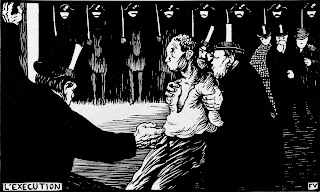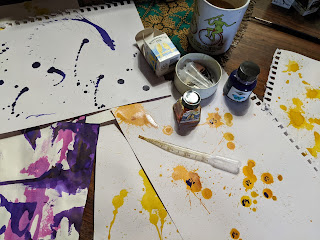Yesterday's news that Kickstarter are moving to become a Blockchain platform has hit the indie gaming community like a bomb. Many people I know immediately declared that they were leaving the platform, others (me included) are very confused/torn on the issue.
My just-completed Kickstarter campaign for Mostly Harmless Meetings was more successful than I had imagined possible. And it fired me up to make a fool's leap into a new life. I am currently long-term unemployed and, I feel, pretty much unemployable (I do have an offer of some work dry-stone walling, but at £30 per back-breaking metre, and with a body that's slowly crumbling under the effects of age, this is not going to butter me many parsnips). The idea that I could make perhaps a grand a month by writing and drawing gives me hope for a slightly more comfortable life for myself and my family.
Kickstarter was a key part of that future life. Other platforms are available - I've heard mention of Gamefound (which I've used as a backer and found incredibly frustrating, plus not all of my future projects will be games); in the past I've backed things on Indiegogo, but that lacks much of the functionality of Kickstarter; and many indie game creators are mooting itch.io as a rising alternative to Kickstarter. I adore itch, in the same way as I adore Bandcamp - it feels very much of the community, by the community, for the community - but just as, if I were a professional musician, I wouldn't rely on Bandcamp to make my living, I'm not sure that itch can generate anything like the audience and revenue that Kickstarter can (certainly that's the case for crowdfunders I have so far followed on itch).
This is, of course, a bit of a self-defeating attitude: only if people start treating itch as a viable alternative to Kickstarter will itch become a viable alternative to Kickstarter. But there is, I think, a bigger problem: itch started as a platform for distributing (for sale and for free) digital games. Both physical products and crowdfunding are features they seem to have bolted on later, and (25 years experience in the tech industry tells me) when platforms move beyond their core functionality they rarely if ever work as well as platforms designed solely to do that "bolt on" feature.
One (important) example of this is that Kickstarter seems to have an amazing recommendation engine. Here are the top few sources of my Kickstarter backers:
In total, £1304 of the £2158 I raised - over 60% - came via recommendations and links within Kickstarter's ecosystem. I can't imagine any of the other platforms providing that level or effectiveness of cross-promotion within the near future.
So what exactly are the issues with Kickstarter moving to Blockchain? As I understand it there are two. Primarily environmental cost. Kickstarter claim that their Blockchain partners are carbon negative; I have a lot of skepticism about companies who claim to be carbon-this or carbon-that - it often means that they have funded the planting of inappropriate monoculture forests which reduce biodiversity. But, in addition to that worry, I have read the following:
So the major tldr is that they're using a cryto-ecosystem called Celo, which is an etherium clone running on proof-of-stake. So at first glance, it's not got the same ruinous environmental impact.
Except.
At the core is a second currency called cUSD which is an "algorithmic stablecoin" which buys and sells other cryptocurrencies to maintain its own value at 1 USD = 1 CUSD. So it's reliant on those other cryptocurrencies and is complicit in an unknown amount of their emissions.
It's also all based around phone numbers Because there's no issues with sim hijacking Also one of the "features" is that if you hold their reserve currency the system might just impose a haircut on you if the value of the currency drops. I am going to stop reading this
Another thing that I've read is that this move shifts the responsibility and trust for pledges from Kickstarter to the chain - I'm not sure how much of an issue this is in the real world, with Blockchain being a relatively mature technology, and I'm not sure whether it involves actual legal changes in responsibility.
I shared the above quote mentioning cUSD with a friend whose knowledge of blockchain goes far beyond anything I could ever achieve and their response was:
Yeah that’s just whining. Let’s see what they actually ship. And how they fine tune it.
And, for now, that's my approach: wait and see. Is this outrage a storm in a teacup, a knee-jerk reaction from people who hear "Blockchain" and think "Cryptobros"? I think it may be, but I'm waiting to learn more. In the meantime, I'd really appreciate hearing the views of those of my friends and associates who work with Blockchain technologies, and those who work for Kickstarter.
Update
This Twitter thread (and replies to it) has given me a somewhat better understanding of the issues involved. tl;dr most people complaining don't understand what they're talking about, but that doesn't mean that there's nothing to complain about.














